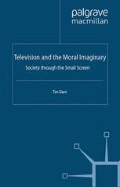Abstract
What makes television a distinctive medium? I have suggested that just what ‘television’ shows us has evolved, and in this chapter I want to point to some of the features that make television different from what it was when if first became a mass medium. John Thornton Caldwell (1995, p. 55) and Jeremy Butler (2010, p. 26) both refer to the traditional form of television in which the medium effaced itself and simply transmitted visual information, as ‘zero-degree style’, by which they mean the process was conventional and not self-consciously stylised.1 This was the standard way of capturing live studio shows (music, games, comedy and variety performances, soap opera) as well as reporting outdoor events including sports, in which the camera simply gave the television viewer the perspective of a spectator at the live event. For recorded drama, there was a stylistic element in that close-ups, and a number of camera angles were used, but the aesthetic was restrained and derived from early movies rather than making distinctive use of what television could do. While the cinema had from the beginning developed an aesthetic interest in the look of the screen imagery that connected with the story of the film, television as a technology was more constrained and directed towards what was live and actual. Things changed as television developed its own distinctive ‘look’, and I will borrow Caldwell’s term ‘televisuality’ to refer to what has become the aesthetic of television as communication, although my use of the term is rather broader than his. For Butler, as we will see, the evolution of a televisual aesthetic is primarily about style, but Caldwell sets the emergence of a distinctive televisual aesthetic against the competition for an audience with cinema and the technological changes in cameras and recording equipment. Television is, after all, an industry in which economic capital is invested and managed with an expectation of a return, either in financial terms or as a public service. To organise the technical equipment and teams of skilled people requires a corporate institutional structure to plan and steer the making and broadcasting of programmes. Unlike one-to-one communication in which the two parties shape communication iteratively according to each of their interests and perspectives, one-to-many communication operates on ideas generated within a corporation with very cumbersome feedback systems of public criticism through other media, individual complaints and comments and the responses of advertisers and regulators, but above all, the information from viewing figures.2 In the early days, the institutional structure was directed toward organising and creating largely live programme content to fill the schedules; things had to be made quickly and did not need to last. But as the technology changed, and the economics of television became more competitive, aesthetics became as important for the small as for the big screen.
Access this chapter
Tax calculation will be finalised at checkout
Purchases are for personal use only
Preview
Unable to display preview. Download preview PDF.
Author information
Authors and Affiliations
Copyright information
© 2012 Tim Dant
About this chapter
Cite this chapter
Dant, T. (2012). Televisuality. In: Television and the Moral Imaginary. Palgrave Macmillan, London. https://doi.org/10.1057/9781137035554_4
Download citation
DOI: https://doi.org/10.1057/9781137035554_4
Publisher Name: Palgrave Macmillan, London
Print ISBN: 978-1-349-31362-4
Online ISBN: 978-1-137-03555-4
eBook Packages: Palgrave Media & Culture CollectionLiterature, Cultural and Media Studies (R0)

